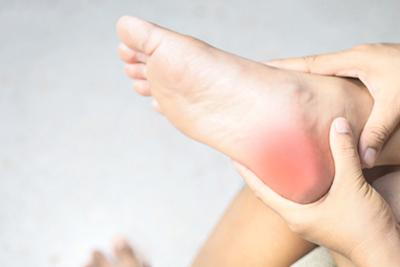Understanding Plantar Fasciitis: Symptoms and Treatments

- posted: Jul. 25, 2024
Foot pain can disrupt your entire life, and plantar fasciitis is one of the most common conditions that cause such pain. Dr. Ryan Slepoy and Dr. Agustin Rios at Associates in Podiatry in Bedford, NH, specialize in treating such conditions and helping you live free from pain.
Understanding Plantar Fasciitis
Your feet have several components, one of which is a thick band of tissue that runs along the bottom to connect the heels to the toes. This band, the plantar fascia, supports your weight and movement every day. Unfortunately, this can lead to overuse, especially if you work on your feet or are very active. Tears develop along the tissue, leading to pain and inflammation. Below, Dr. Slepoy, Dr. Rios, and the team at Associates in Podiatry in Bedford, NH, share the symptoms of plantar fasciitis and how the condition can be treated.
Common Symptoms To Watch For
When the plantar fascia is damaged, you’ll notice some or all of the following signs:.
- Pain along the bottom of the foot, usually close to the heel, which could be sharp or a dull ache
- Stiffness, especially upon waking up
- Pain that worsens or seems to only be present when your feet touch the floor in the morning and eases after a few minutes of movement
- Pain that gets worse when you are active, such as when running or walking up stairs
How Is It Treated?
Healing a damaged plantar fascia often involves a variety of methods. The first is being more merciful to your feet by taking breaks, letting them rest, and modifying your activities. Ice is also beneficial, especially when swelling is present.
Footwear can play a critical role in healing and preventing further damage. Ensuring you have proper support for your arches and that your weight is distributed properly is key. Sometimes this can be done by changing shoes. However, custom orthotics can be more effective, as they are designed around the structure of your foot, your gait, and other factors.
Stretches and exercises can be beneficial for both loosening tight tissues and strengthening support muscles. Cold laser therapy, massage therapy, and other techniques can improve blood flow to the feet, which can help relieve pain and enhance healing.
Typically, conservative methods such as these will provide the necessary relief. However, in severe cases, surgery and other procedures may be recommended.
Find freedom from the symptoms of plantar fasciitis in the hands of Dr. Slepoy and Dr. Rios at Associates in Podiatry in Bedford, NH. Call (603) 471-9933 to schedule an appointment today.

- posted: Jul. 25, 2024
Foot pain can disrupt your entire life, and plantar fasciitis is one of the most common conditions that cause such pain. Dr. Ryan Slepoy and Dr. Agustin Rios at Associates in Podiatry in Bedford, NH, specialize in treating such conditions and helping you live free from pain.
Understanding Plantar Fasciitis
Your feet have several components, one of which is a thick band of tissue that runs along the bottom to connect the heels to the toes. This band, the plantar fascia, supports your weight and movement every day. Unfortunately, this can lead to overuse, especially if you work on your feet or are very active. Tears develop along the tissue, leading to pain and inflammation. Below, Dr. Slepoy, Dr. Rios, and the team at Associates in Podiatry in Bedford, NH, share the symptoms of plantar fasciitis and how the condition can be treated.
Common Symptoms To Watch For
When the plantar fascia is damaged, you’ll notice some or all of the following signs:.
- Pain along the bottom of the foot, usually close to the heel, which could be sharp or a dull ache
- Stiffness, especially upon waking up
- Pain that worsens or seems to only be present when your feet touch the floor in the morning and eases after a few minutes of movement
- Pain that gets worse when you are active, such as when running or walking up stairs
How Is It Treated?
Healing a damaged plantar fascia often involves a variety of methods. The first is being more merciful to your feet by taking breaks, letting them rest, and modifying your activities. Ice is also beneficial, especially when swelling is present.
Footwear can play a critical role in healing and preventing further damage. Ensuring you have proper support for your arches and that your weight is distributed properly is key. Sometimes this can be done by changing shoes. However, custom orthotics can be more effective, as they are designed around the structure of your foot, your gait, and other factors.
Stretches and exercises can be beneficial for both loosening tight tissues and strengthening support muscles. Cold laser therapy, massage therapy, and other techniques can improve blood flow to the feet, which can help relieve pain and enhance healing.
Typically, conservative methods such as these will provide the necessary relief. However, in severe cases, surgery and other procedures may be recommended.
Find freedom from the symptoms of plantar fasciitis in the hands of Dr. Slepoy and Dr. Rios at Associates in Podiatry in Bedford, NH. Call (603) 471-9933 to schedule an appointment today.
Our Location
Find us on the map
Associates in Podiatry
18 Constitution Drive
Bedford, NH 03110, US